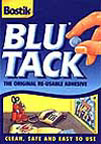Workshop Plus
WORKSHOPS 2025
- Latest posts:
- Ida Wk4
- Debra Wk2
- Carolyn Wk7
- Susan Wk2
Ida (Online Advanced)
WEEK 4: EXERCISE 1
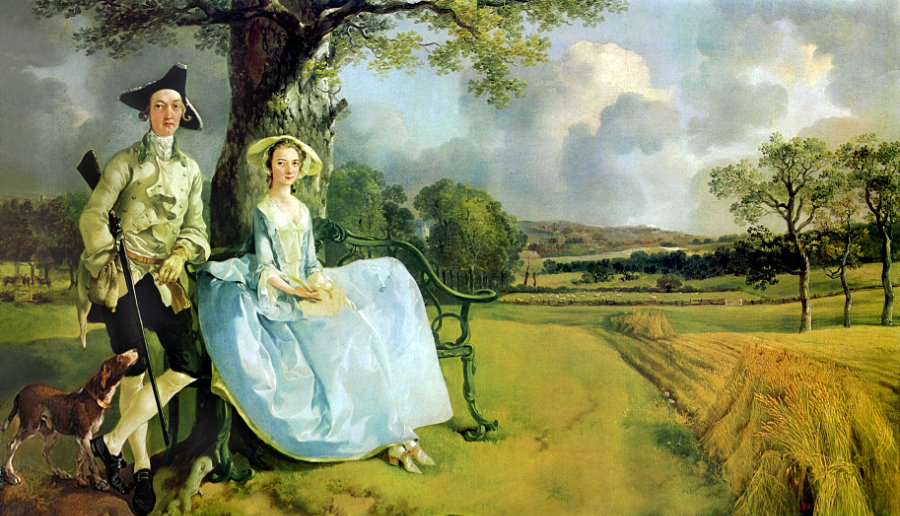
I look at the dogs nose, which leads me to the rifle. I then follow the rifle up to the waistband of the gentleman and then I meet his eyes.
I start there, too. That might be because it's the area of greatest contrast, brightest colours, and sharpest detail. Like you, I tend to first notice the dog, or Mr Andrews' leg because it the brightest in the painting, and then to the dog.
My eye then travels up the shotgun to Mr A's tricorn hat. From there, the hat sometimes points me up into the tree, which has branches that send me down the right-hand side. Or I follow the hat to Mrs A, and then follow the bench arm into the right-hand side.
Incidentally, the overhanging branch of the tree prevents your eye from leaving and pushes your view down to the wheat sheaves, which are leaning towards the background, leading you back to the sheep. The row of trees on the left then push back to the rolling hills and up to the clouded sky. Even the clouds seem to curve to the left.
In fact, almost anywhere you look, you can find subtle pointers that steer you around and back to the couple. Except for the quiet area with the deer and the barn, above the dog's head and to the left of Mr Andrews. That area provides a resting place for the viewer, so you're not forced to continually circuit. It's a device I've used myself, and it can work very well.
Lighting around the couple reinforces them as the focal point. Throughout the painting are spots of interest to stop and ponder. The small white flowers by the wheat, the sheep in the field, deer behind the couple on the left. What started out being a basic painting really can become quite fascinating with examination.
The more you look into paintings like these, the more you learn about the tricks used to control your route. And, of course, the more you can incorporate into your own work.
You might have also noticed Mr Andrews' haughty look of superiority? I've forgotten the whole story, but Gainsborough detested working for this class of person. They hated the countryside but wanted to display their land, and Gainsborough was deliberately unkind to them in this painting - in ways you'd recognise if you knew the clues to look for, although the clues are probably meaningless is this later age.
Where's the horizon or eye-level? Technically, I think the eye-level would appear to be low. There is very little to go on, because most elements are organic, so I went looking for anything man-made. The bench is the only element available, and it's quite clear that we can see the front edge of the seat but not its top. So I'm conjecturing that the seat is exactly at eye-level. If that's true, it would explain the feeling of the couple's superiority. They really are looking down on us.
Personally, I find the mechanics of composition to be absolutely fascinating, and I have done from way back in my school days. Doc Irwin, my English Literature master, was passionately interested in two subjects - collecting comic books, and advertising design. I can still remember the day that he explained the layout of a toothpaste ad - how the eye was forced to travel a prescribed route and always ended up on the product itself. It was that single explanation that fired my imagination and interest in the subject.
If this journey of my eyes was intentional by the artist, it's really cool. I'll try this with more paintings to see what I'm actually seeing :-)
I don't know what Gainsborough's intentions were, but this painting certainly guides you around and keeps you moving. You really must try this with as many other paintings as you can. Just think in terms of "stoppers" and "pointers". Those two are my terms - I've no idea if they have official names.
Next week you'll find more of my thoughts on this painting and its composition.
Debra (Assisted Online Intermediate)
WEEK 2: EXERCISE 1
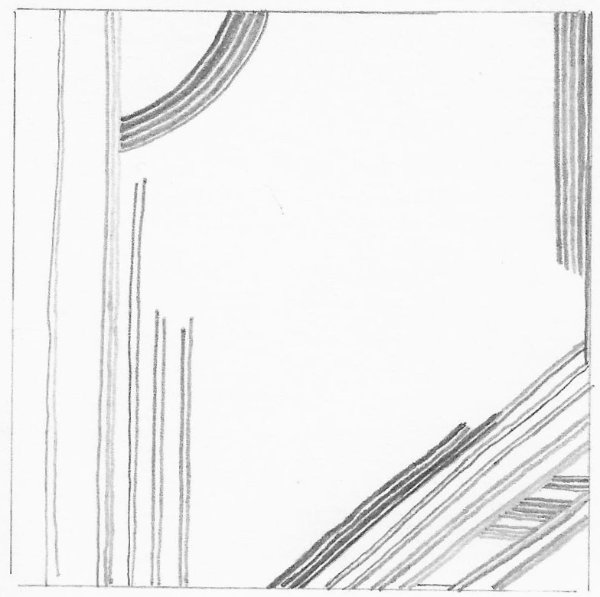
WEEK 2: EXERCISE 2
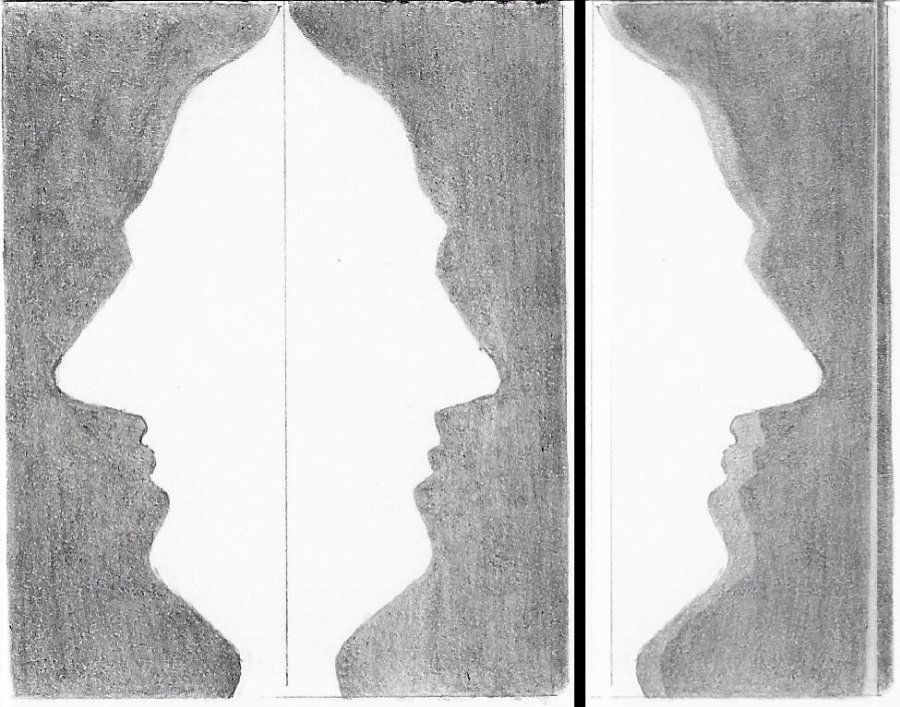
I did not do the cutting and switching as I am aware of this exercise and I wanted to get on to the next exercise.
Fair enough!
This is a very accurate result. As with Susan's, I flipped the left-hand half over onto the right-hand half... and apart from the longer nose, they're remarkably similar. Well done!
WEEK 2: EXERCISE 3
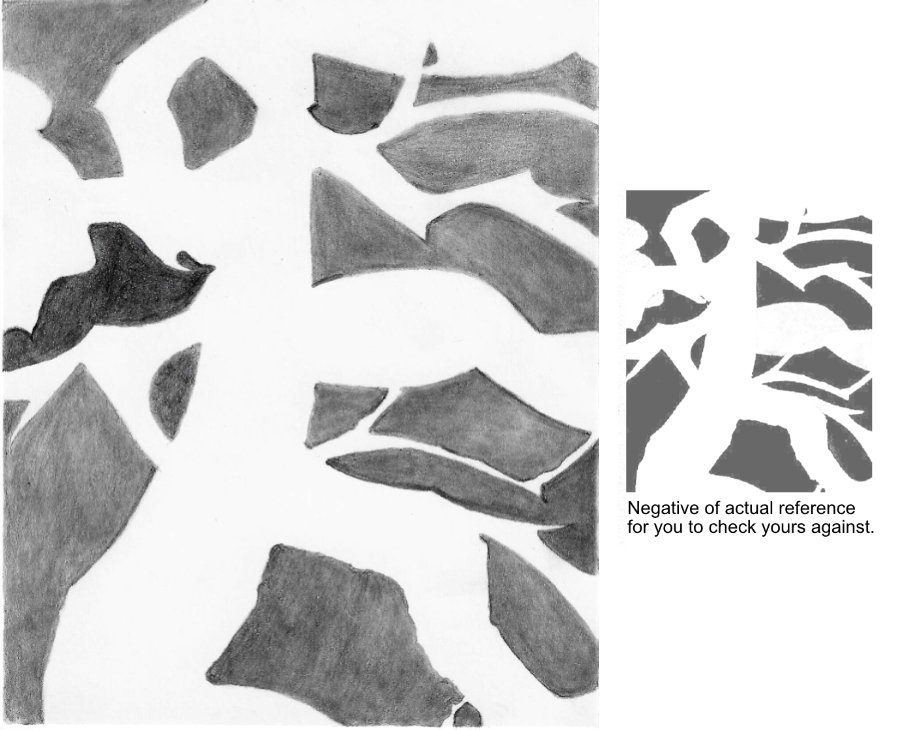
This was hard! I found I often saw what needed to be a bump or projection in the negative space and did not interpret it correctly. I can see why you emphasize practice. Overall, I " get" the concept but the devil is in the details.
Good work, Debra, this is virtually flawless. Keep practising. Once you become used to seeing negative space, you'll find it's an incredibly powerful tool with a myriad of uses - especially when you have problems correctly seeing a positive shape. Switching to drawing the negative spaces around it almost always solves the problem. And the good news... it becomes progressively easier with practice.
I also learned a lesson.. I got so involved in trying to get a shape correct that I forgot to move the card that protects the work from my hand. When I finished, I discovered I had smeared half of the picture. Not funny! Glad I learned that on a lesson and not on an actual piece. I tried to correct the smear as best I could but as you have mentioned in the past, it will never be the pristine white.
I'm really pleased that happened and that it happened when it did. It is unlikely you'll make that mistake again, and this time is was of little consequence.
I once found a fingerprint of mine in an otherwise flawless sky. Fingerprints cannot be removed, so I spent two days painstakingly darkening the sky around the fingerprint until it disappeared. Never again will I cause that to happen!
Carolyn (Online Advanced)
WEEK 7 EXERCISE 1
I have trouble understanding the directions, but I think this shows that I should take a box out in the sun and look at it in real life! Only then will I fully understand, I think.
That really is the best solution. I learned with an array of objects and a desklamp - but the principle is the same. And as soon as it begins to all make sense, you'll find it so much easier to just create shadows on the fly.
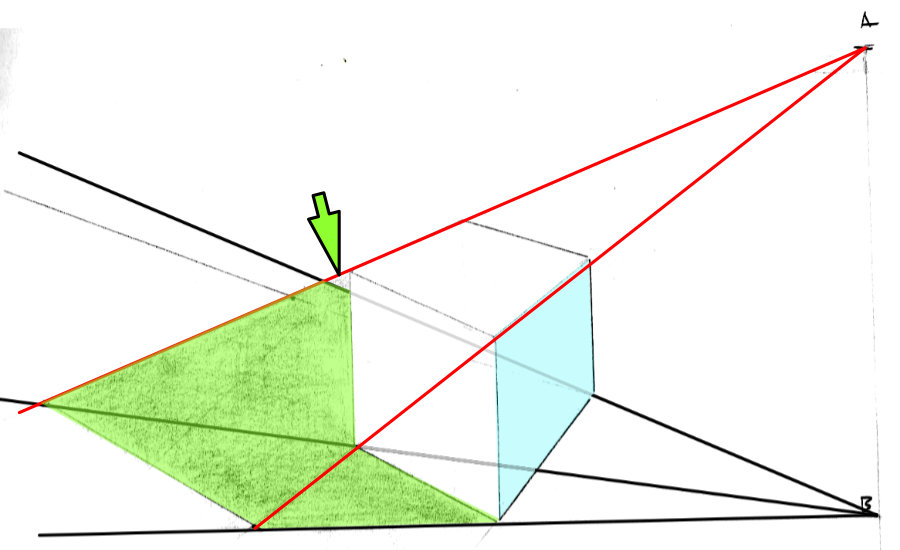
As A is directly above B, A can only see the light blue face and the top. So my red lines follow the corners I can see from up there.
Everywhere else, the light can see the ground. You've made life a little difficult for yourself because one face of the cube exactly follows the same red line . But you were almost entirely correct - just the tiny arrowed section was wrong.
OK.. let's move on to VERSION 2:
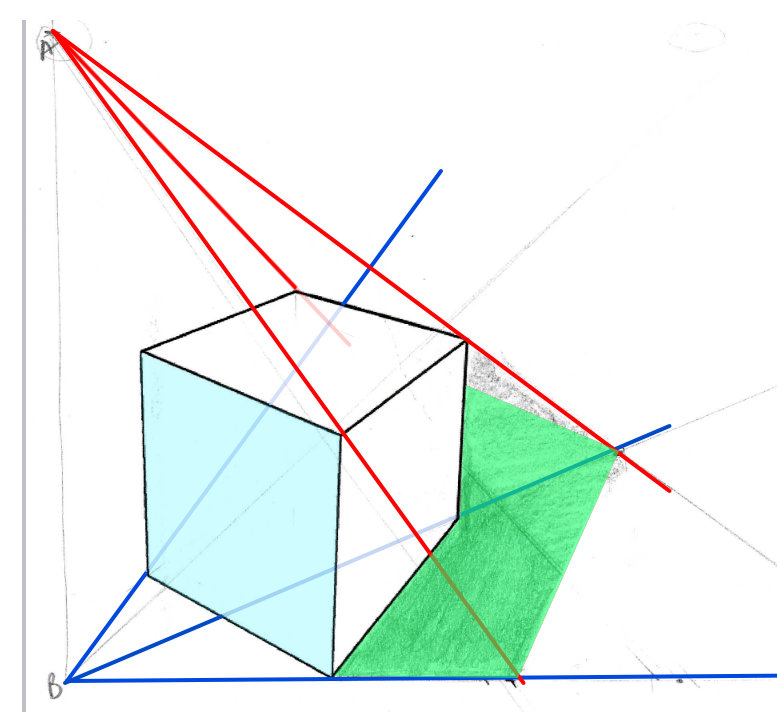
This might help you - assuming you need it!
Now what can you see from up there? Which are the furthest edges you can see that might block your vision of the ground? From up here (as the light) I can maybe see the top's left and right-hand corners and the far corner. The near corner doesn't count because I can see all the faces that spring from it. Now imagine where your line of sight for each corner meets the ground, allowing for any unevenness.
WEEK 7 EXERCISE 2
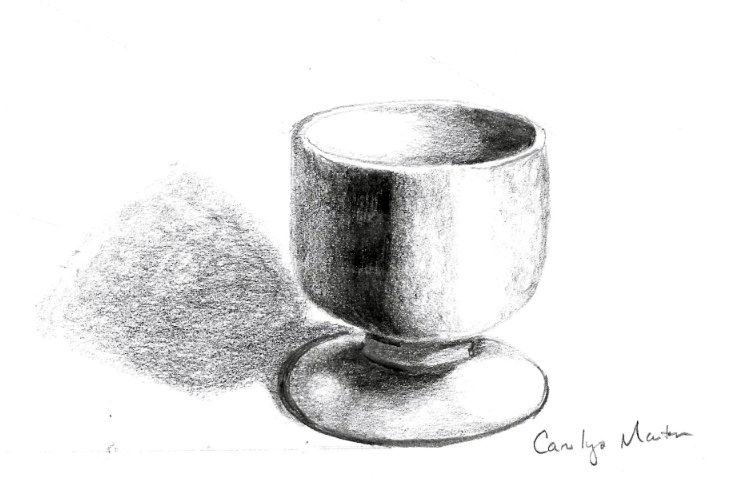
I'm not sure how to apply the angles for figuring lighting to a rounded object... I'm not happy with it but want to see what you say.
I'm sorry I haven't the time to work this out completely, but I have this one stored from a previous session, which is very similar:
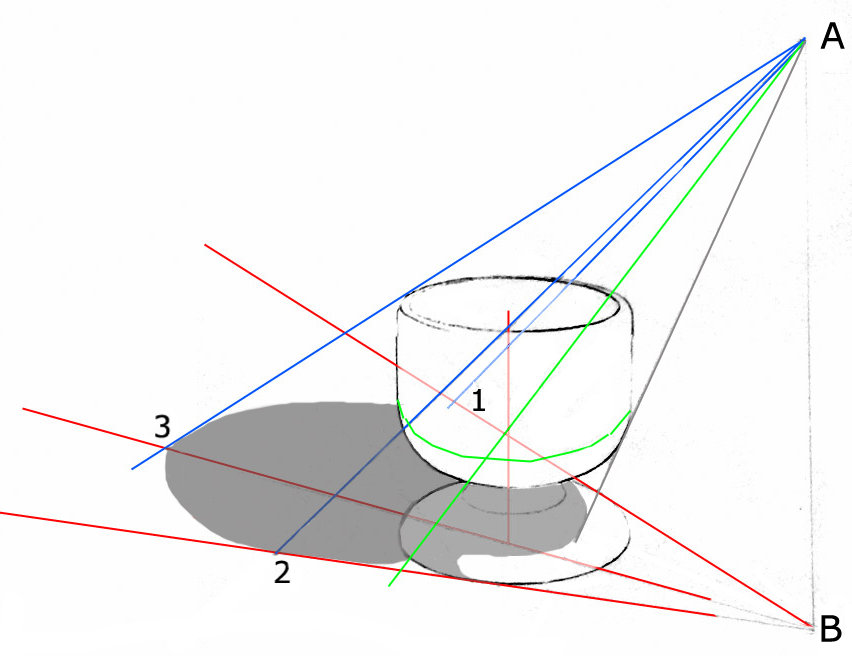
Red 1 and 2 give me the maximum width of the shadow. I'm assuming the cup and its base are the same width.
Blue 1 and 2 pass both sides at its widest point (as seen from A), which gives me the points at which the curve of the shadow meets the shadow of the sides.
Green is a line around the cup where the vertical side begins to curve underneath. The green ray passes through that curve (directly under the blue "widest point" above) so I now know where the shadow begins to curve back in.
The grey line marks where the shadow of the cup begins on its base.
The rest is eyeballed.
Enclosing it in a box won't work, because the corners of the box will all extend further out than the object itself. Construct the ground plane lines. Then, again, imagine you're the light. What can't you see from up there?
WEEK 7 EXERCISE 3
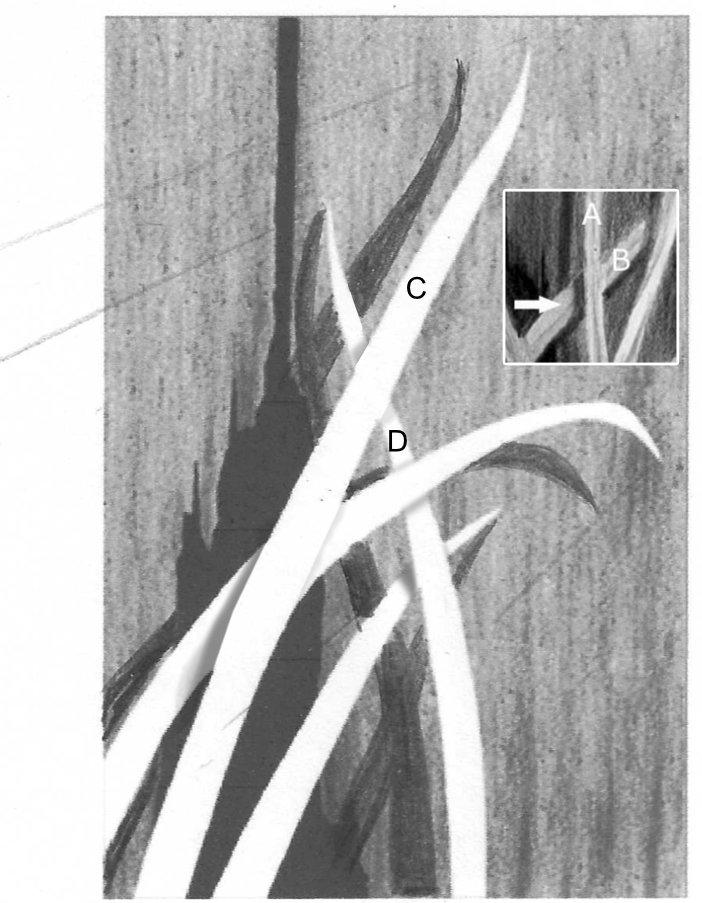
Otherwise this is very good. Those lines are exactly what you needed to do. This is splitting hairs a bit but, because this is sunlight, they should ALL be at the same angle. Due to its extreme distance as a light source, you can always assume sunlight rays travel in parallel straight lines. Also, your sun is very low in the sky, which is why my shadow cast by Leaf C on Leaf D is above the leaf rather than below.
But what really matters is that your cast shadows on the wall instantly describe the way each leaf bends, and their distance from the wall at any point. It's clearly obvious that some leaves bend back to touch the wall and others run parallel to it or lean back slightly.
As for the internal cast shadows... The further away the surface is from the leaf, the further the shadow has to travel. When the shadow of a leaf is projected both onto the wall AND another leaf, the shadow will split. The shadow of A on B (arrowed) has less distance to travel so it is nearer to A than the shadow of B cast on the wall.
In your drawing, the shadow of Leaf C on D has less distance to travel so it is nearer to C than the shadow cast on the wall. The shadows depend on which you think is in front of which, and what the angles of the leaves are. I've also introduced a little darker tone along the other edge of each leaf, just to define it. That's OK, but it has to be very subtle.
I hope this exercise proved to you how important and effective shadows are - even when the elements themselves contain no three-dimensional shaping.
Susan (Assisted Online Intermediate)
WEEK 2 EXERCISE 1

The trick is to look at the white line as you draw the dark lines. That way the feedback from your mind to your hand is focused on the narrow white line. Try a few more, because it's an exercise well worth the effort.
WEEK 2 EXERCISE 2
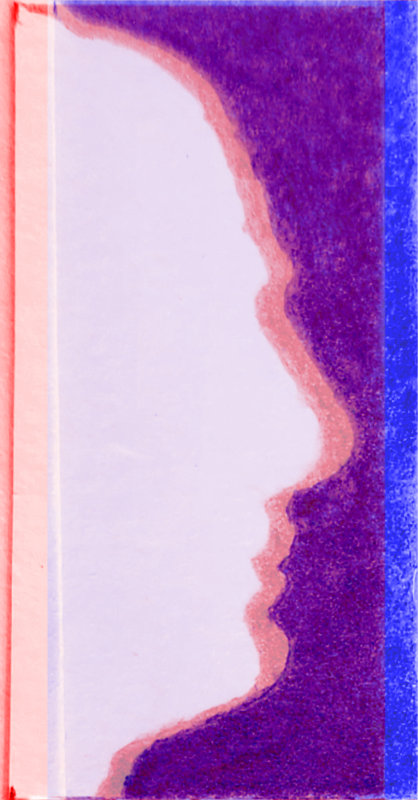
Well! It's essentially about using the negative space between the shape and the frame to reconstruct it. I won't make the second part public for obvious reasons.
The red is your right half recoloured. Then I flipped the left half, recoloured it blue, and laid it over the blue. It was such a perfect match that I had to offset the blue half to the right just to appreciate how wonderfully alike they are.
As you discovered, by studying and copying the space between the lines and borders (the abstract negative space) you were avoiding drawing recognisable shapes. I once spent a day trying to get the correct curve of a dog's bottom eyelid. It was only when I looked at the surrounding negative space, and drawing that, that I realised my brain was telling me the curve was convex (because that's what my brain expected to see) where in reality it was concave.
It can take time to train yourself to see negative space in everything but, once you've achieved the ability to switch between positive shape and negative space, you'll find it invaluable.
Recommended viewing:
NEGATIVE SPACE: Intro
NEGATIVE SPACE: Part 1
NEGATIVE SPACE: Part 2
WEEK 2 EXERCISE 3
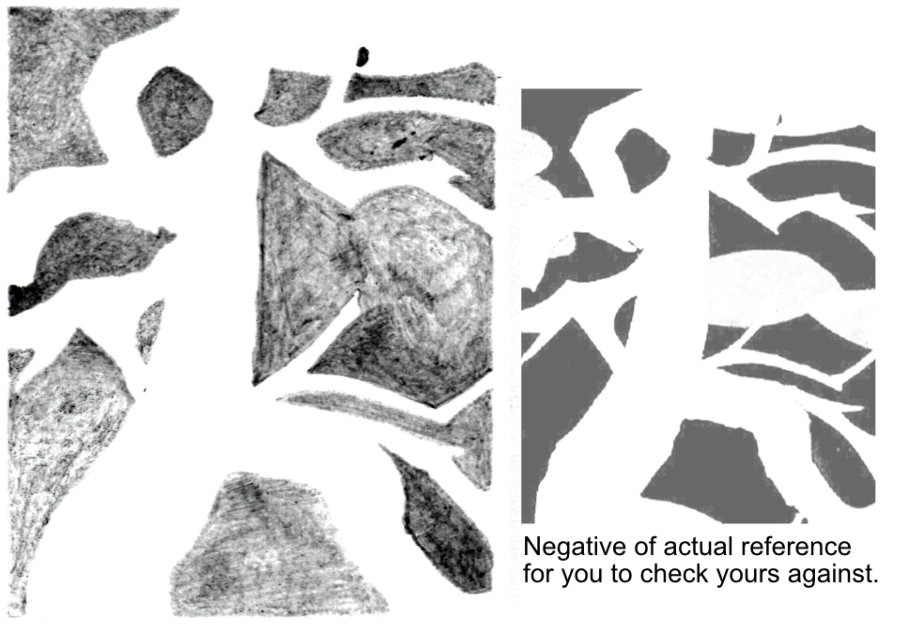
I can't begin to describe how powerful and useful being able to see negative space is. Without going into it too deeply... we possess an inbuilt recognition system. It uses icons for speed and those icons are simple full-face images. A mouth, for example, is stored facing us, never at an angle. It's for safety recognition - if you see a mouthful of large teeth heading in your direction you need to flee. You'll recognise it instantly, even if you don't recognise the animal the teeth belong to. The latter is unimportant, the former isn't!
This should help explain everything: NEGATIVE SPACE INTRO
The greatest problem to overcome when drawing is to ignore the whole system. If you allow it to operate you will draw what you "know" rather than what you see - a three-quarter angled face, for example, that you adorn with a mouth facing the viewer.
It's also a logical "left brain" thing that loves to name things. "That's a MOUTH!" It is, but it's the stored generic mouth - not the mouth in your reference.
The best way to defeat the detection/naming problem is to study and draw the negative space around the nameable feature. The negative space is abstract and cannot be recognised as being "something". Whenever I have a problem correctly visualising something, I look at the negative spaces around it. It has solved countless problems over the years.
WEEK 2 EXERCISE 4
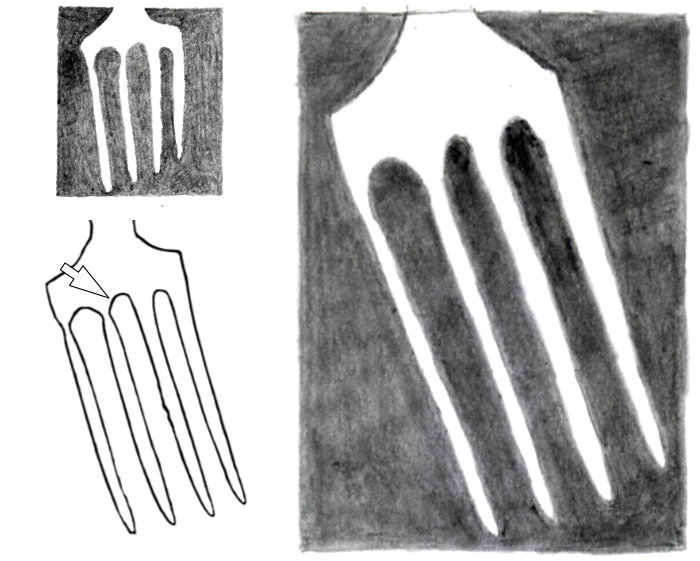
I did a 'practice' first...everything was out of proportion.
But at least you were practicing, and that's never a bad idea.
Well, my shading of the negative space around the fork looks like my 6-year old granddaughter has been drawing. Actually...she might do a better job!
Sign her up! Maybe do the Foundation course first...
Well, my shading of the negative space around the fork looks like my 6-year old granddaughter has been drawing. Actually...she might do a better job!
The tines (prongs) are not bad at all but... you appear to have not noticed that the tines have subtly curved edges and seen them as being straight, which a lot of artists do. Compare it to the outline I've included and you'll see what I mean.
However, I'm principally looking at the curves between the tops of the tines, as this method is ideal for capturing those accurately. Two out three's not bad going but the third (arrowed) is a shadow of its true self... I think you drew what you expected to see. In that case, you were looking at the curve and not the negative space around it. Use a piece of card, your pencil, your finger, anything that will hide the curve except the part you want to draw. Look at the negative space around it and draw that.
This is a deceptively difficult subject but the card method should have shown you exactly how each of those curves was formed.
Laying a piece of card along them will show you exactly how those curves are individually formed - exactly as they are. That's the beauty of this method, it divorces what you expect to see from what is actually there. Capturing such subtle differences can often make the difference between a successful drawing and a problematic one. Probably your viewers won't know why something "looks wrong" but it will unsettle them and damage the overall reality.
These will help you:
NEGATIVE SPACE: Introduction
NEGATIVE SPACE: Part 1
NEGATIVE SPACE: Part 2
Tutorials
by Mike Sibley



